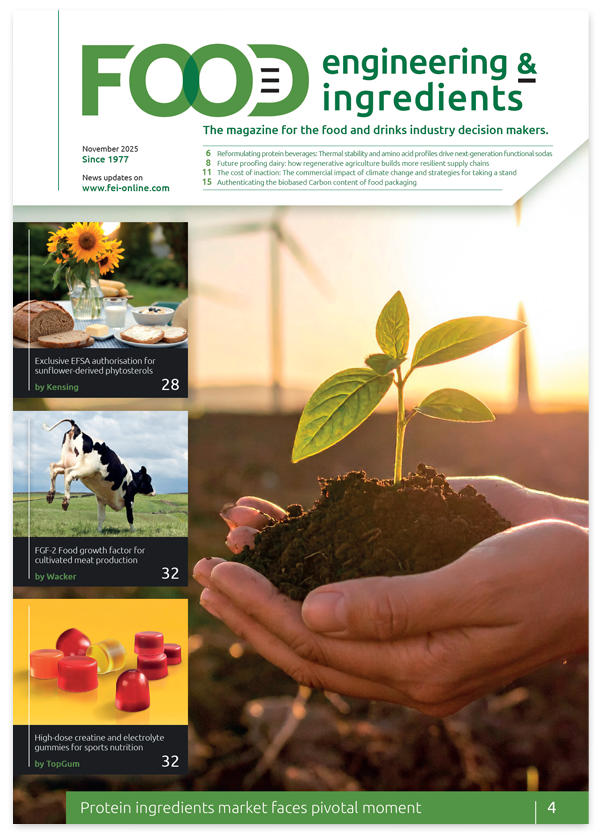TikTok for food ingredients: How to leverage the platform for your brand
As consumers become more interested in what goes into their food and supplements, ingredient branding is taking centre stage on TikTok. In this article, Paul Pflästerer, Co-owner of akp Communications, examines why this trend is booming and the approaches manufacturers can take to harness it.
Ingredient branding has become an essential tool for companies in the food and supplement industry. Today, consumers actively seek out high-quality ingredients, impacting not only their own purchases but also the decisions of manufacturers and retailers. Social media platforms such as Instagram and TikTok have even transformed how brands engage with these informed audiences by offering new ways to showcase ingredient value. What was once seen as a space solely for entertainment and dance trends is now a platform where food and ingredient manufacturers can tell compelling stories, build trust and drive demand.
Value of transparency?
One of the key reasons socials are so relevant for ingredient branding is the growing trend of self-education in nutrition. Consumers not only want to know what is in their food but also understand why specific ingredients make a difference. Studies show that 85% of consumers worldwide consider ingredient transparency a key factor in their purchasing decisions. This means that brands capable of properly positioning their ingredient can directly influence buying behaviour, and Instagram and TikTok might be the most direct and effective channels to communicate their message.
Building trust through transparency is crucial in the food industry, especially given the declining confidence in food brands. In Europe, only 46% of consumers trust food brands, and scepticism is similarly high in the U.S. Ingredient brands have a unique opportunity to counteract this trend by using short, engaging, behind-the-scenes videos to show where their ingredients come from, their beneficial effects and the science behind them. Authenticity and transparency are key factors in building consumer confidence.
Surprisingly diverse audience
A common misconception is that TikTok is only relevant for Gen Z but this is simply not true. As of mid-2024, 31% of TikTok users were over the age of 35. This demographic includes health-conscious, active consumers with purchasing power. Moreover, TikTok’s algorithm works differently from traditional social media platforms as it is content driven. This means brands don’t need a massive number of followers to gain traction – they simply need engaging, relevant content.
Shaping brands through collaborations
When it comes to content strategies, certain formats perform particularly well. Short explainer videos lasting between 15 and 30 seconds are an effective way to highlight an ingredient’s benefits. Ingredient spotlights showcase how a specific ingredient enhances a product, while testimonials from real users add credibility. Collaborating with influencers and industry multipliers in the health and nutrition space is another powerful approach. A respected nutritionist or fitness expert incorporating a particular ingredient into their daily routine will highly resonate with target audiences.
Turn your ingredient into a must-have
Traditionally, ingredient brands sell to food manufacturers, who then produce final products for consumers. However, ingredient branding introduces an additional layer by enabling direct communi-
cation with end customers. When they recognize and actively seek out a specific branded ingredient, food manufacturers face increased pressure to include that ingredient in their formulations. Social media plays a crucial role in creating this pull effect, making it easier for ingredient brands to educate and influence consumer purchasing decisions.
What approaches can an ingredient manufacturer take?
Educational content: Ingredient manufacturers can create short, engaging videos that explain what their branded ingredient does and why it is unique. For example manufacturer of an innovative low-calorie sugar substitute might focus on showing how its ingredient maintains sweetness without spiking blood sugar levels, helping food manufacturers develop healthier products that make you feel fuller for longer. Educational videos like these position the brand owner as a credible expert and convey added value to viewers in the form of knowledge.
Case studies and brand partnerships: Highlighting real-world applications of the ingredient within well-known products can be powerful. An antioxidant ingredient manufacturer might showcase how its ingredient is used in popular energy bars or supplements, emphasising the health benefits it confers and promoting trust. A TikTok video featuring branded products that incorporate the ingredient will build credibility and demonstrate relevance, showing audiences how the ingredient enhances their favourite products. Influencer partnerships: Leveraging influencers who focus on health, nutrition or fitness can amplify reach and engagement. For instance, a branded prebiotic fibre manufacturer could partner with a nutrition influencer to discuss the benefits of fibre for digestive health. Influencers add a relatable, real-world angle that resonates well with audiences, especially when demonstrating an ingredient’s impact within everyday routines.
What are the best formats for ingredient branding on TikTok?
Quick explainer videos: These concise videos (15-30 seconds) can explain the benefits of the ingredient, using visuals and simple language. For instance, a branded, low-glycaemic sugar substitute might create a 20-second video explaining how it sweetens without impacting blood sugar, making it great for diabetics and those watching their sugar intake.
Ingredient spotlights and use cases: Highlight specific health benefits in a way that’s easy to grasp. Videos that explore how these branded ingredients fit into daily life can be highly effective. For example, short, visually engaging content might show how adding a branded antioxidant to a smoothie provides a daily immunity boost.
Testimonials and personal experiences: Testimonials play a critical role in ingredient branding on TikTok by allowing real users to share their experiences with branded ingredients, building trust among potential consumers. When users or influencers describe the tangible benefits they’ve experienced – such as improved energy from a branded antioxidant or better digestive health from a prebiotic fibre – viewers see authentic, relatable proof of the ingredient’s effectiveness. These personal stories resonate powerfully, as they provide social validation and reassure consumers that the ingredient truly delivers on its promises. This kind of testimonial content fosters credibility and confidence, making it more likely that viewers will trust and seek out products featuring these branded ingredients.
An agency can help
For manufacturers considering Instagram or TikTok but unsure where to start, a clear strategy is essential. Defining the target audience and key messages is the first step. Content should be engaging, educational and visually appealing. Transparency is critical – showing consumers why an ingredient matters, how it is sourced and what benefits it delivers will make a significant difference. If resources are limited, partnering with an agency can accelerate success, ensuring creative and effective execution.
About the author
Paul Pflästerer, Co-owner of akp Communications GmbH, has a rich background in journalism and public relations. Having worked as an editor for several newspapers and studied public relations, he joined akp Communications four years ago. Since then, his focus has been on developing PR strategies and digital campaigns. Founded over 20 years ago, akp specializes in the food & beverage industry, helping global B2B clients achieve their communication objectives through innovative and strategic approaches.
Tik Tok ingredient branding examples
Glycine by Dr. Christal Blanchard ND (@drchristalnd) https://shorturl.at/xBdGI
Collagen by Dr. Kay (@dr.kay.longevity) https://shorturl.at/fBUOh
Magnesium and zinc by Medical Wonders (@medialwonders) https://shorturl.at/cVxv0
Zinc by Claire the Nutritionist (@clairethenutritionist) https://shorturl.at/IuAId







